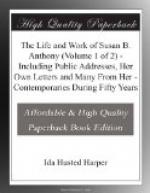This was Miss Anthony’s first visit to Kansas and she found much to interest her in Leavenworth—caravans of emigrants long trains of supplies for the army, troops from the barracks crowds of colored refugees, the many features of frontier life so totally different from all she had seen and known in her eastern home. The prominence of her brother brought many distinguished visitors to his house, she enjoyed the long carriage drives and the days were filled with pleasant duties, so that she writes, “I am afraid I shall get into the business of being comfortable.” On her birthday, February 15, the diary shows that she wagered a pair of gloves with the family physician that it would not rain before morning, and on the 16th is recorded: “The bell rang early this morning and a boy left a box containing a pair of gloves with the compliments of the doctor.” In March one entry reads: “The new seamstress starts in pretty well but she can not sew nicely enough for the little clothes. We shall have to make those ourselves.”
This life of ease proved to be of short duration. Her brother was renominated for mayor and plunged at once into the thick of a political campaign, while Miss Anthony went to the office to help manage his newspaper, limited only by his injunction “not to have it all woman’s rights and negro suffrage.” The labor, however, which she most enjoyed was among the colored refugees. Soon after the slaves were set free they flocked to Kansas in large numbers, and what should be done with this great body of uneducated, untrained and irresponsible people was a perplexing question. She went into the day schools, Sunday-schools, charitable societies and all organizations for their relief and improvement. The journal shows that four or five days or evenings every week were given to this work and that she formed an equal rights league among them. A colored printer was put into the composing-room, and at once the entire force went on strike. The diary declares “it is a burning, blistering shame,” and relates her attempts to secure other work for him. She met at this time Hiram Revels, a colored Methodist preacher, afterwards United States senator from Mississippi.
During these months she was in constant receipt of letters pressing her to return to the East. Phillips said: “Come back, there is work for you here.” From Lydia Mott came the pathetic cry: “Our old fraternity is no more; we are divided, bodily and spiritually, and I seem to grow more isolated every day.” Pillsbury wrote: “We do not know much now about one another. We called a meeting of the Hovey Committee and only Whipple and I were present. Why have you deserted the field of action at a time like this, at an hour unparalleled in almost twenty centuries? If you watch our papers you must have observed that with you gone, our forces are scattered until I can almost truly say with him of old, ‘I only am left.’ It is not for me to decide your field of labor. Kansas needed John Brown and may need you. It is no doubt missionary ground and, wherever you are, I know you will not be idle; but New York is to revise her constitution next year and, if you are absent, who is to make the plea for woman?” Mrs. Stanton insisted that she should not remain buried in Kansas and concluded a long letter:




